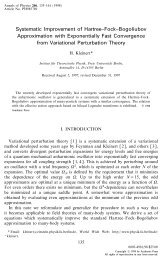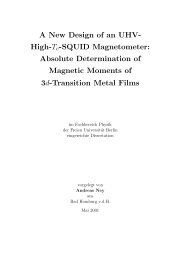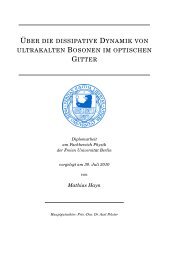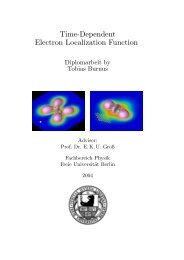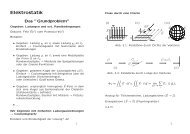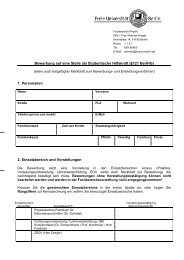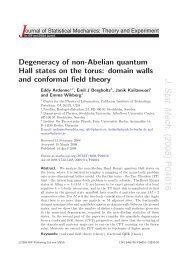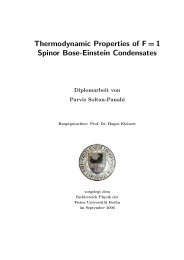Diploma thesis
Diploma thesis
Diploma thesis
Create successful ePaper yourself
Turn your PDF publications into a flip-book with our unique Google optimized e-Paper software.
3 Complex square well potential<br />
We took only an example for one particular waist ω = 0.8, since the general qualitative behaviour<br />
of k- and n-states is the same for all waists. Fig. 3.8 shows how the densities develop and change<br />
their shape from the familiar form for c = 0, which corresponds to the ordinary symmetric and<br />
antisymmetric states of the real square well potential with m maxima, to large c. It directly becomes<br />
clear how the behaviour of k- and n-states differs for increasing dissipation. While densities<br />
of k-states tend to the borders, that is area 1 and 3, these of n-states tend to the center, that<br />
is area 2, for increasing c. We remember, that for ω → π , which yields an imaginary potential<br />
2<br />
well affecting the whole system, only n-states occur, while the k-states dominate the system for<br />
ω = 0. This is related to the fact that for c → ∞ two independent potential wells are formed,<br />
which means that the states of the respective wells have densities equal to zero in the respective<br />
other well.<br />
Thus an appropriate interpretation of the saturation values (3.31) becomes obvious. The observation<br />
that two independent potential wells emerge, matches perfectly to the fact that the real part<br />
of the energies of the n-states, which then are confined to the inner well with the width 2w, become<br />
these of an ordinary potential well with exactly this width. In contrast a k-state is confined to<br />
the borders, that is area 1 and 3. Since this is a non-connected region only antisymmetric states<br />
fit since a maximum of the density in the center is not possible. From (3.31) we saw that we can<br />
interpret the whole situation also as 3 independent potential wells with the width of each area so<br />
that every well is a connected region and thus both symmetric and antisymmetric states emerge.<br />
Both interpretations are possible since the corresponding energies are the same:<br />
E k =<br />
2 π 2<br />
2M[2(L − w)] 2 (2k)2 =<br />
2 π 2<br />
2M(L − w) 2 k2 . (3.34)<br />
The more appropriate interpretation will become apparent while evaluating more general systems<br />
where this equality between states living in area 1 and 3, respectively, is not valid any more.<br />
Let us also have a look at the time evolution of these densities. Since we only aim at having a<br />
general impression of this, we restrict ourselves only to two cases, that is two waists, where we<br />
show the effect of the imaginary potential on the time evolution exemplarily. Therefore we take<br />
on the one hand the data of the particular experiment, that is (3.25), and on the other hand<br />
ω = 0.8 and c = 100 for which we already plotted the densities. First it seems to be reasonable<br />
to renormalize also the time t and to deal with the corresponding dimensionless quantity:<br />
τ :=<br />
π2 t. (3.35)<br />
8ML2 Inserting , M and L especially for our system provides t = τ · 4.5 s. Thus (2.8) reads<br />
ρ(χ, τ) = exp [2ε I (τ − τ 0 )] ρ(χ, τ 0 ). (3.36)<br />
Now we consider for both data a superposition of the (m = 1)- and the (m = 4)-state, that is<br />
√1<br />
2<br />
(|1〉 + |4〉). Let us start with (3.25). Although we did not plot the corresponding densities in<br />
this case, the considered waist is so small that the antisymmetric state does not change much<br />
for increasing c, so it is nearly equal to the (m = 4)-state for c = 0. In contrast to this the<br />
24




